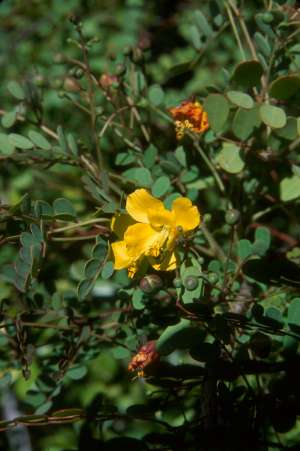Plants of South Florida · Plants by Conservation Area · Plants by County · Plants by Habitat Quick Search · Advanced Search |
||
|
|
||
 |
Caesalpinia pauciflora (Griseb.) C. Wright Fewflower holdback |
|
|
South Florida Status: Critically imperiled. One occurrence at the National Key Deer Refuge and surrounding private properties on Big Pine Key. Taxonomy: Dicotyledon; Fabaceae. Habit: Shrub. Distribution: Native to South Florida and the West Indies. South Florida Distribution: Monroe County Keys. South Florida Habitats: Pine rocklands. Protection Status: Listed as endangered by FDACS and as critically imperiled by FNAI. Aids to Identification: Scurlock (1987) has color photos; Chafin (2000) has illustrations and a color photo. References: Chapman, 1883; Small, 1933a; Isely, 1982; Long & Lakela, 1976; Isely, 1980; Scurlock, 1987; Nelson, 1996; Wunderlin, 1998; Chafin, 2000; Coile, 2000. Synonyms: None. Historical Context: Allan H. Curtiss first collected fewflower holdback in 1880 on Big Pine Key (713, US, NY). Since that collection, numerous other collections have been made on Big Pine Key, where the species occurs today within the boundaries of National Key Deer Refuge. T. Ann Williams has observed plants on Big Pine Key in pinelands south of Watson Boulevard and east of Key Deer Boulevard, and in another area in a pineland near the industrial area behind the Chamber of Commerce building (personal communication, 6 March 2001). Francis W. Pennell vouchered plants on Cudjoe Key in 1917 (9563, US). It was not seen there again until George N. Avery observed it in 1964 and 1965 (Avery’s Notes, 1964-1965). Bruce F. Hansen and others vouchered it there in 1985 (10674, USF, FTG). Presumably this station was in or near National Key Deer Refuge property on the island. In 1964, Avery discovered a population on Summerland Key (Avery’s Notes, 11 February 1964). Robert W. Long and R. Broome vouchered this population in 1967 (2480, USF). No recent reports from this island have been seen, and it is probably extirpated there. Suitable habitat for this species may exist on other islands, such as Sugarloaf Key or Little Pine Key. T. Ann Williams has searched for this species extensively on No Name Key to no avail (personal communication, 6 March 2001). Davis (1942) reported fewflower holdback from the lower Sandy Keys, west of Key West. No specimens from this area have been seen. Gann and Bradley surveyed this area in 1996, but no plants were seen. Davis’ report may have been made in error. Major Threats: Fire suppression; exotic pest plant invasions; habitat destruction; sea-level rise. Recommendations: • Survey Cudjoe Key and Summerland Key. • Map and monitor known stations on a regular basis. • Acquire private sites with populations of fewflower holdback and add to National Key Deer Refuge. Update: Recent population estimates by Keith A. Bradley indicate that there are more than 25,000 individuals in the Florida Keys, thus changing its status to rare in South Florida. Citation: Gann, G.D. 2006-2012. Species Account Update, Floristic Inventory of South Florida Database Online. The Institute for Regional Conservation. Delray Beach, Florida. |
||



